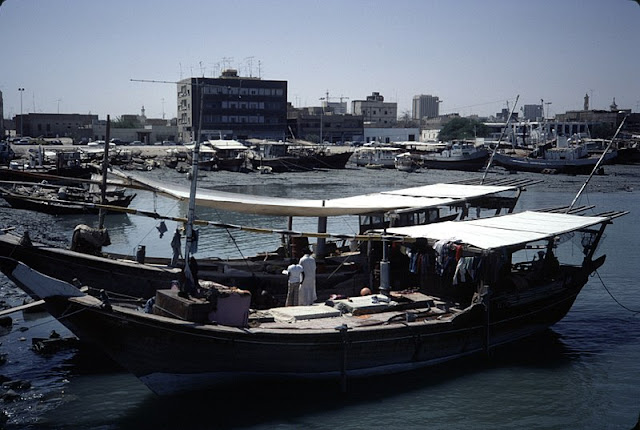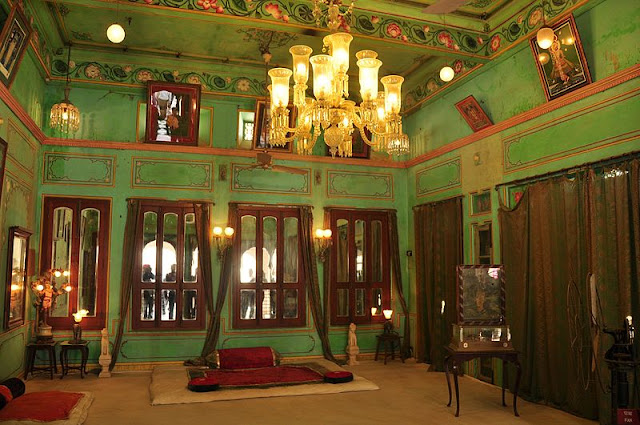Traditional fishing
The traditional fishing method is based on the use of traps made from reed rods tied together. They dig into the shore in the form of a straight wall, towards the shore, perpendicular to the coastline to low tide. At the end that is at sea, the wall ends with a trap in the form of bent identical stakes. In some cases, the trap has a small branch, access to which is possible through a narrow slot in the main trap. During high tide, the fish moves to the shore and then tries to sail back when the tide comes. Moving along the coast, she stumbles upon a wall of reed rods and floats along with it, trying to get into the deep waters. So, moving along the obstacle, the fish falls into the trap. Trying to get out of it, she falls into the gap through which she goes into a smaller trap. There she remains until the owner of the trap passes along the shore and collects the fish.Date Palm
Known as the Desert Bride, the palm tree (Nahil Al-Balah Al-Arabi) has been growing in the Gulf region for centuries. Date palms are valued for their economic and decorative virtues.The tree has acquired various meanings over the centuries; it symbolizes health, culture and historical integrity. There are more than 1000 species of date palm trees. This tree is extremely suitable to withstand harsh environmental conditions. Usually, it grows to 60-80 feet in height, and its crown consists of 20-foot leaves. Soft fruits ripen in place of the flowers of the female individual. Dates are not only sweet but also nutritious. After the recession in the pearl business and before oil began to generate annual income for Kuwait, the main emphasis was on dates. Statistics show that most Kuwaitis have contributed to palm growth, especially in Basra. The products were then exported to various markets, including India.
Diwa
Diwa, or men's salon, is an integral part of Kuwaiti political and social life. For men, the reputation of divan is one of many ways to achieve respect in society. In the evenings, men gather in a specially designated room, which is separated from the rest in the house. Visitors have casual conversations, smoke, eat a light meal and relax with tea or coffee. Sometimes, during more unofficial divas, hearty food is served. The nature of divas can range from official gatherings used by eminent Kuwaitis as a venue for public gatherings and platforms, from gatherings organized by the host to entertain their friends, to small unofficial divans where the club atmosphere reigns. In many divas, it is customary to remove shoes before entering. Particular care must be taken to ensure that your legs are not aimed directly at another person. Although most visitors sit on the floor, cushions or soft benches, chairs are also provided for in large European-style divas. Falconry Some of the traditional Kuwaiti hunts have emerged from the habitat of the desert. Falconry is one of these species. The training period for wild falcons lasts about three weeks and begins with the fact that the owner gives each falcon a separate nickname. A soft leather cap is attached to the falcon with leather laces, and when the bird is accustomed to the owner, the cap is removed to establish visual contact, an individual connection is established. The pleasure received from communication and friendship with a wild animal is a unique experience of partnership in this sport, which has existed since time immemorial.Diwa
Diwa is the main place for discussions on social, political and business topics. Some sofas specialize in specific areas, such as politics or science, so men can attend different sofas for different purposes. For businessmen and executives, divas offer an excellent opportunity for interesting contacts. The clothing styles of both Kuwaiti men and Kuwaiti women reflect their environment, traditions, values and religious beliefs. Most men prefer to weartraditional clothing all year round - white in the summer months and dark in winter. A characteristic white robe with a floor-length (dishdasha) and a pure white headdress became a symbol of the national costume. A simple, but elegant, and most importantly, ideally suited for the hot desert climate, the suit is preferred, as it reflects heat and allows air to circulate around the body. The headdress consists of three parts: kefiya, closed, adjacent cap, hutra, a large square piece of fabric and agal that holds it all on his head. On official occasions, men also put on a cloak (bisht) over the dishdashi. Fashion among Kuwaiti women also reflects their values. In Kuwait, mainly three styles of clothing are common - Western, traditional and Islamic. The traditional costume (Darrah) is a veil gracefully falling in a straight line from the shoulders to the ankles. Sewed usually from bright fabrics, Darrah can be simple or decorated with colored embroidery. Another version of the traditional costume is a long flared skirt to the ankles, a jacket with long sleeves and a strict blazer or a loose jacket. a large square piece of fabric and agal that holds it all on his head. On official occasions, men also put on a cloak (bisht) over the dishdashi. Fashion among Kuwaiti women also reflects their values. In Kuwait, mainly three styles of clothing are common - Western, traditional and Islamic. The traditional costume (Darrah) is a veil gracefully falling in a straight line from the shoulders to the ankles. Sewed usually from bright fabrics, Darrah can be simple or decorated with colored embroidery. Another version of the traditional costume is a long flared skirt to the ankles, a jacket with long sleeves and a strict blazer or a loose jacket. a large square piece of fabric and agal that holds it all on his head. On official occasions, men also put on a cloak (bisht) over the dishdashi. Fashion among Kuwaiti women also reflects their values. In Kuwait, mainly three styles of clothing are common - Western, traditional and Islamic. The traditional costume (Darrah) is a veil gracefully falling in a straight line from the shoulders to the ankles. Sewed usually from bright fabrics, Darrah can be simple or decorated with colored embroidery. Another version of the traditional costume is a long flared skirt to the ankles, a jacket with long sleeves and a strict blazer or a loose jacket. which holds it all on his head. On official occasions, men also put on a cloak (bisht) over the dishdashi. Fashion among Kuwaiti women also reflects their values. In Kuwait, mainly three styles of clothing are common - Western, traditional and Islamic. The traditional costume (Darrah) is a veil gracefully falling in a straight line from the shoulders to the ankles. Sewed usually from bright fabrics, Darrah can be simple or decorated with colored embroidery. Another version of the traditional costume is a long flared skirt to the ankles, a jacket with long sleeves and a strict blazer or a loose jacket. which holds it all on his head. On official occasions, men also put on a cloak (bisht) over the dishdashi. Fashion among Kuwaiti women also reflects their values. In Kuwait, mainly three styles of clothing are common - Western, traditional and Islamic. The traditional costume (Darrah) is a veil gracefully falling in a straight line from the shoulders to the ankles. Sewed usually from bright fabrics, Darrah can be simple or decorated with colored embroidery. Another version of the traditional costume is a long flared skirt to the ankles, a jacket with long sleeves and a strict blazer or a loose jacket. On official occasions, men also put on a cloak (bisht) over the dishdashi. Fashion among Kuwaiti women also reflects their values. In Kuwait, mainly three styles of clothing are common - Western, traditional and Islamic. The traditional costume (Darrah) is a veil gracefully falling in a straight line from the shoulders to the ankles. Sewed usually from bright fabrics, Darrah can be simple or decorated with colored embroidery. Another version of the traditional costume is a long flared skirt to the ankles, a jacket with long sleeves and a strict blazer or a loose jacket. On official occasions, men also put on a cloak (bisht) over the dishdashi. Fashion among Kuwaiti women also reflects their values. In Kuwait, mainly three styles of clothing are common - Western, traditional and Islamic. The traditional costume (Darrah) is a veil gracefully falling in a straight line from the shoulders to the ankles. Sewed usually from bright fabrics, Darrah can be simple or decorated with colored embroidery. Another version of the traditional costume is a long flared skirt to the ankles, a jacket with long sleeves and a strict blazer or a loose jacket. Fashion among
Kuwaiti women also reflect their values. In Kuwait, mainly three styles of clothing are common - Western, traditional and Islamic. The traditional costume (Darrah) is a veil gracefully falling in a straight line from the shoulders to the ankles. Sewed usually from bright fabrics, Darrah can be simple or decorated with colored embroidery. Another version of the traditional costume is a long flared skirt to the ankles, a jacket with long sleeves and a strict blazer or a loose jacket. Fashion among Kuwaiti women also reflects their values. In Kuwait, mainly three styles of clothing are common - Western, traditional and Islamic. The traditional costume (Darrah) is a veil gracefully falling in a straight line from the shoulders to the ankles. Sewed usually from bright fabrics, Darrah can be simple or decorated with colored embroidery. Another version of the traditional costume is a long flared skirt to the ankles, a jacket with long sleeves and a strict blazer or a loose jacket. gracefully flowing in a straight line from the shoulders to the ankles. Sewed usually from bright fabrics, Darrah can be simple or decorated with colored embroidery. Another version of the traditional costume is a long flared skirt to the ankles, a jacket with long sleeves and a strict blazer or a loose jacket. gracefully flowing in a straight line from the shoulders to the ankles. Sewed usually from bright fabrics, Darrah can be simple or decorated with colored embroidery. Another version of the traditional costume is a long flared skirt to the ankles, a jacket with long sleeves and a strict blazer or a loose jacket.








.jpg)

No comments:
Post a Comment
Please Dont Enter Any Spam Link in The Comment Box